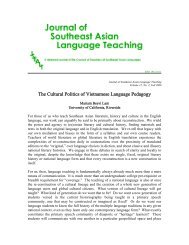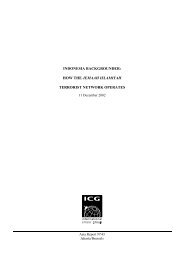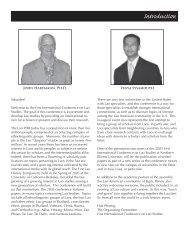The Non-Issue of Dialect in Teaching Vietnamese Andrea ... - SEAsite
The Non-Issue of Dialect in Teaching Vietnamese Andrea ... - SEAsite
The Non-Issue of Dialect in Teaching Vietnamese Andrea ... - SEAsite
Create successful ePaper yourself
Turn your PDF publications into a flip-book with our unique Google optimized e-Paper software.
ISSN 1932 3611<br />
Journal <strong>of</strong> Southeast Asian Language Teach<strong>in</strong>g, Volume 14, 2008<br />
<strong>The</strong> <strong>Non</strong>-<strong>Issue</strong> <strong>of</strong> <strong>Dialect</strong> <strong>in</strong> Teach<strong>in</strong>g <strong>Vietnamese</strong><br />
<strong>Andrea</strong> Hoa Pham<br />
Abstract<br />
<strong>The</strong>re is grow<strong>in</strong>g discussion concern<strong>in</strong>g which dialect <strong>of</strong> <strong>Vietnamese</strong><br />
should be taught <strong>in</strong> North American classrooms. This paper discusses certa<strong>in</strong><br />
phonological differences between the Hanoi and Saigon dialects to show<br />
that the two dialects are structurally equal and socially adequate, a<br />
claim that has important implications for plann<strong>in</strong>g language programs.<br />
1. Introduction<br />
Choos<strong>in</strong>g which <strong>Vietnamese</strong> dialect to use <strong>in</strong> classrooms has been a constant<br />
concern, especially when the surround<strong>in</strong>g community is made up <strong>of</strong> speakers <strong>of</strong> different<br />
dialects. This paper is motivated by two <strong>in</strong>cidents: first, a student’s question: “Why are the<br />
majority <strong>of</strong> <strong>in</strong>structors <strong>of</strong> <strong>Vietnamese</strong> (<strong>in</strong> the United States) Northerners?”; second, a<br />
conversation with a colleague which revealed that the major, if not only, concern <strong>in</strong> hir<strong>in</strong>g a<br />
<strong>Vietnamese</strong> <strong>in</strong>structor for a vacant position was which dialect the candidate spoke.<br />
<strong>Dialect</strong> selection has become a burn<strong>in</strong>g issue for the North American <strong>Vietnamese</strong><br />
classroom <strong>in</strong> particular because it is not only associated with dialect stigmatization, which<br />
we can f<strong>in</strong>d <strong>in</strong> any language, i.e., ‘standard’ vs ‘nonstandard’, but the dialects bear political<br />
stigmatization. Assumptions are all too readily made about a teacher’s political background<br />
on the basis <strong>of</strong> the person’s choice <strong>of</strong> dialect to teach. L<strong>in</strong>guistically, the Northern dialects,<br />
represented here as the ‘Hanoi’ dialect, are <strong>of</strong>ten assumed to be ‘better’ for students to<br />
learn, because they are deemed ‘standard’, or ‘more correct’, or supposedly help students to<br />
avoid spell<strong>in</strong>g mistakes. <strong>The</strong> speech <strong>of</strong> Southerners, represented here as the ‘Saigon’<br />
dialect, is meanwhile said to be ‘less precise’ <strong>in</strong> comparison, because Northern speakers<br />
pronounce almost all sounds dist<strong>in</strong>guished <strong>in</strong> the orthography. 1 <strong>The</strong> ‘Saigon’ dialect is<br />
1<br />
<strong>The</strong> <strong>Vietnamese</strong> orthography is phonetic-based <strong>in</strong> that, with very few exceptions, one symbol represents one<br />
sound and one sound is represented by one symbol. Data <strong>in</strong> this paper is shown <strong>in</strong> italics <strong>in</strong> the <strong>Vietnamese</strong><br />
22
widely deemed <strong>in</strong>adequate and therefore less desirable to learn. Decisions that flow from<br />
this ill-founded notion, although largely hidden, can have unfortunate impacts on classroom<br />
success, teacher hir<strong>in</strong>g, program development and overseas studies plann<strong>in</strong>g. <strong>The</strong>y can also<br />
affect collegial relationships.<br />
Accord<strong>in</strong>gly, the follow<strong>in</strong>g questions will be addressed: Which dialect ‘should’ one<br />
teach? Does it have to be a ‘standard’ dialect? Which is the ‘standard’ dialect <strong>of</strong><br />
<strong>Vietnamese</strong>? Is it true that any dialect that deviates from the ‘standard’ dialect is ‘slovenly<br />
and bad’? How much can a dialect deviate and still be ‘acceptable’? Is it true that students<br />
should learn the ‘correct’ or ‘best’ dialect rather than one conta<strong>in</strong><strong>in</strong>g ‘improper’, ‘outdated’,<br />
and ‘backward’ forms (as po<strong>in</strong>ted out <strong>in</strong> Lam 2006)? Are some dialects ‘stable’, e.g.,<br />
‘standard ones’, and others not so, e.g., ‘nonstandard ones’?<br />
This paper will show that the two major dialects used <strong>in</strong> classrooms <strong>in</strong> North<br />
America - one spoken <strong>in</strong> Hanoi and surround<strong>in</strong>g areas and the other one spoken <strong>in</strong> Saigon<br />
and surround<strong>in</strong>g areas - are socially and structurally adequate to use for teach<strong>in</strong>g and<br />
learn<strong>in</strong>g. It emphasizes that none <strong>of</strong> the <strong>Vietnamese</strong> dialects is ‘wrong’ or ‘<strong>in</strong>complete’. It<br />
also discusses some sound changes <strong>in</strong> progress <strong>in</strong> both major dialects, and stresses that<br />
change is normal, neither bad nor good. Change is a natural process <strong>in</strong> any and all<br />
languages and dialects. All this sounds natural and obvious to l<strong>in</strong>guists, however it may not<br />
be so to language teachers, adm<strong>in</strong>istrators and members <strong>of</strong> the general public. This article is<br />
primarily designed to benefit teachers and adm<strong>in</strong>istrators who are dedicated to teach<strong>in</strong>g the<br />
language. <strong>The</strong> article should <strong>in</strong>terest scholars <strong>of</strong> <strong>Vietnamese</strong> l<strong>in</strong>guistics as well.<br />
2. Socio-historical and language background<br />
Unlike <strong>in</strong>structors <strong>in</strong> Vietnam, those who teach the language to <strong>Vietnamese</strong> children<br />
and others <strong>in</strong> the United States or Canada <strong>of</strong>ten have to contend with bias: the possible<br />
political stigma associated with the dialect he or she speaks.<br />
“Almost all <strong>in</strong>structors <strong>of</strong> <strong>Vietnamese</strong> <strong>in</strong> the States are immigrants” (Lam 2006). 2<br />
Many <strong>of</strong> them or their parents fled North Vietnam for the South <strong>in</strong> 1954 and then overseas<br />
after the reunification <strong>of</strong> Vietnam <strong>in</strong> 1975. <strong>The</strong>se immigrants speak Northern dialects<br />
<strong>Vietnamese</strong> with the pre-1975 Northern accent, which is somewhat different from the<br />
‘contemporary’ post-1975 accent <strong>of</strong> those who lived <strong>in</strong> the North dur<strong>in</strong>g the partition <strong>of</strong><br />
Vietnam. For the most part the parents <strong>of</strong> "heritage students" arrived as those refugees after<br />
1975. Instructors who speak the pre-1975 Northern dialects left the country for the same<br />
political reasons as the parents <strong>of</strong> these students. However, <strong>in</strong>structors with northern<br />
accents, whether ‘pre’ or ‘post’-1975, are <strong>of</strong>ten labeled ‘communists’, especially if they<br />
recently came to the United States directly from the North. <strong>The</strong> <strong>in</strong>structor is <strong>of</strong>ten treated<br />
with suspicion until he/she makes his/her political views clear.<br />
Accord<strong>in</strong>g to Lam 2006, although most refugees speak the Southern dialects,<br />
Northern dialects historically dom<strong>in</strong>ate the classrooms <strong>of</strong> the University <strong>of</strong> California<br />
system. Because Northern dialects are pervasive, students who are speakers <strong>of</strong> Southern<br />
orthography with a phonetic transcription for l<strong>in</strong>guistic readers. Tones are shown <strong>in</strong> only the orthography<br />
unless there is some discussion <strong>of</strong> an issue <strong>in</strong>volv<strong>in</strong>g tone.<br />
2<br />
<strong>The</strong> situation has gradually changed as younger <strong>in</strong>structors from Vietnam with some background <strong>in</strong> the<br />
American school system are appo<strong>in</strong>ted to teach the language <strong>in</strong> the United States.<br />
23
dialects are told they use ‘improper’, ‘outdated’, and ‘backward’ forms. Parents then<br />
compla<strong>in</strong> about their child's experience with bias, and students are discouraged from tak<strong>in</strong>g<br />
<strong>Vietnamese</strong> at a higher level. Adm<strong>in</strong>istrators are sometimes puzzled and surprised at this,<br />
not hav<strong>in</strong>g appreciated the social and political forces at work <strong>in</strong> the classroom.<br />
Because <strong>of</strong> the historical and socio-political context <strong>of</strong> Saigon and the <strong>in</strong>crease <strong>of</strong><br />
immigrants from many different areas, Cao & Lê 2005 suggest us<strong>in</strong>g the term ‘Saigon<br />
dialect’ only for the speech <strong>of</strong> educated speakers liv<strong>in</strong>g <strong>in</strong> Saigon and cities around Saigon.<br />
In Cao & Lê’s sense, the Saigon dialect is a social dialect rather than a geographical one,<br />
similar to the dist<strong>in</strong>ction between the speech <strong>of</strong> well-educated speakers <strong>of</strong> English <strong>in</strong><br />
Brita<strong>in</strong> no matter where they live, and the dialects <strong>of</strong> uneducated English speakers. <strong>The</strong><br />
Saigon dialect that Huỳnh 1999 describes is the speech <strong>of</strong> those liv<strong>in</strong>g <strong>in</strong> Saigon. Because<br />
<strong>of</strong> the natural and historical conditions <strong>of</strong> Saigon and the areas surround<strong>in</strong>g Saigon, which<br />
is called Nam Bộ, the Saigon dialect is regarded as part <strong>of</strong> a much larger unified dialect <strong>of</strong><br />
Nam Bộ, spoken from Đồng Nai to Cà Mau. This dialect is also the variety described <strong>in</strong><br />
this paper. <strong>The</strong> follow<strong>in</strong>g sections will present the phonological differences between the<br />
two major dialects commonly used <strong>in</strong> classrooms, Northern dialects (i.e. ‘Hanoi’) and<br />
Southern dialects (i.e. ‘Saigon’). It will focus on pronunciation <strong>in</strong> order to show that (i)<br />
although these dialects are structurally different they are both adequate for language<br />
learn<strong>in</strong>g; and (ii) language changes occur <strong>in</strong> all dialects and such changes are natural and to<br />
be expected.<br />
First a brief remark on orthography is needed <strong>in</strong> order to understand the concept <strong>of</strong><br />
‘standard dialect’ <strong>in</strong> <strong>Vietnamese</strong>, as discussed later <strong>in</strong> the paper. <strong>The</strong> sound contrasts <strong>in</strong> a<br />
language or dialect are reflected <strong>in</strong> alphabetical writ<strong>in</strong>g systems. For example, <strong>in</strong> English<br />
bat and fat differ from each other only <strong>in</strong> the <strong>in</strong>itial consonants written as b and f because<br />
[b] and [f] are different sounds <strong>in</strong> English. A perfect spell<strong>in</strong>g system has a one-to-one<br />
correspondence between sounds and letters. Obviously, English does not have a perfect<br />
system. <strong>The</strong> <strong>Vietnamese</strong> writ<strong>in</strong>g system tries to capture all the different sounds found <strong>in</strong><br />
any dialect <strong>of</strong> the language <strong>in</strong> its spell<strong>in</strong>g system. However, there are some dialects which<br />
do not have certa<strong>in</strong> differences <strong>in</strong> sounds. If a particular dialect does not have such a sound<br />
difference <strong>in</strong> the orthography, it is wrong to say that <strong>in</strong> such a case, the dialect is not<br />
‘correct’, or not ‘complete”. For example, Northerners differentiate lán [la⎤n] ‘long house’<br />
and láng [la⎤Ν] ‘be sh<strong>in</strong>y, smooth’ while Southerners have the same pronunciation for these<br />
words, láng [la⎤Ν]. 3 Notice that because the two words are written differently to show the<br />
contrast between the two sounds n [n] and ng [Ν], an educated Southern speaker may th<strong>in</strong>k<br />
that he/she should be mak<strong>in</strong>g a difference between the two sounds because the spell<strong>in</strong>g<br />
shows such a difference. This k<strong>in</strong>d <strong>of</strong> awareness can lead to confusion between ‘sound’ and<br />
‘letter’, i.e., between speech and writ<strong>in</strong>g, a confusion endemic <strong>in</strong> the m<strong>in</strong>ds <strong>of</strong> many<br />
pr<strong>of</strong>essional teachers <strong>of</strong> foreign and native languages. It is not unusual to hear speakers<br />
from Central Vietnam or the South say that ‘speakers <strong>of</strong> our dialect do not pronounce<br />
<strong>Vietnamese</strong> correctly’, ‘I know I say th<strong>in</strong>gs wrong’, etc. It is uncommon to hear a similar<br />
remark from a Northerner, because as we will see below, the Northern dialects ‘lack’ only<br />
three sounds that are represented <strong>in</strong> the <strong>Vietnamese</strong> spell<strong>in</strong>g system. Spell<strong>in</strong>g mistakes that<br />
3<br />
In this paper the data are represented both <strong>in</strong> the <strong>Vietnamese</strong> orthography for non-l<strong>in</strong>guists and <strong>in</strong> phonetic<br />
symbols for those who are <strong>in</strong>terested. Tones are shown <strong>in</strong> the orthography only, unless it is a discussed issue<br />
(see Phạm 2006 for a phonological analysis <strong>of</strong> the Hanoi and Saigon dialects).<br />
24
orig<strong>in</strong>ate from different regional pronunciations can be seen from time to time <strong>in</strong><br />
newspapers, magaz<strong>in</strong>es, and creative writ<strong>in</strong>gs. Such errors are mistakenly attributed to<br />
wrong pronunciation. People who make them are regarded as not well-educated or careless<br />
writers.<br />
Tables 1 and 2 present the <strong>in</strong>itial consonant <strong>in</strong>ventories <strong>of</strong> the Hanoi and Saigon<br />
dialects, respectively. <strong>The</strong> description <strong>of</strong> the sound system <strong>of</strong> the Saigon dialect is based on<br />
Huỳnh 2005 and Pham 2006. <strong>The</strong> <strong>in</strong>itial consonants <strong>in</strong> the Hanoi dialect are given <strong>in</strong> Table<br />
1. This table uses standard orthography. In most cases the orthographic and phonetic<br />
symbols are identical, e.g., the sound [b] is written as b <strong>in</strong> the orthography. Where the<br />
orthographic symbol is different from the phonetic symbol, the phonetic symbol is put <strong>in</strong><br />
parentheses beside the letter, e.g., the sound [c] is written as ch. In some cases more than<br />
one letter is used for a sound, depend<strong>in</strong>g on the follow<strong>in</strong>g vowel, e.g. [⊗] is written as gh<br />
before front vowels and g elsewhere. <strong>The</strong> glottal stop is unmarked <strong>in</strong> the orthography.<br />
Huỳnh 1999 and some other researchers do not <strong>in</strong>clude the glottal stop <strong>in</strong> the <strong>in</strong>itial<br />
<strong>in</strong>ventory <strong>of</strong> <strong>Vietnamese</strong>, which is presented <strong>in</strong> others such as Doan 1977, Nguyen 1997<br />
and this paper.<br />
labial alveolar Palatal Velar glottal<br />
th [tΗ]<br />
t ch [c] c, k, q [k]<br />
b đ [d] [?]<br />
m n nh [⎠] ng, ngh [Å‹]<br />
ph [f] x [s] kh [x] H<br />
v d, gi [z] g, gh [⊗]<br />
l<br />
Table 1. <strong>The</strong> <strong>in</strong>itial <strong>in</strong>ventory <strong>in</strong> the Hanoi dialect<br />
Table 2 shows <strong>in</strong>itial consonants <strong>in</strong> the Saigon dialect. <strong>The</strong> Saigon dialect does not have v<br />
[v] but it does have three retr<strong>of</strong>lexes tr, s, and r [ , Σ, ⏐] that are also represented <strong>in</strong> the<br />
orthography.<br />
labial alveolar retr<strong>of</strong>lex Palatal Velar glottal<br />
th [tΗ]<br />
t tr [ ] ch [c] c, k, q [k]<br />
b đ [d] [?]<br />
m n nh [⎠] ng, ngh<br />
25
[Ν]<br />
ph [f] x [s] s [Σ] kh [x] H<br />
w r [⏐] v, d, gi [j] g, gh [⊗]<br />
l<br />
Table 2. <strong>The</strong> <strong>in</strong>itial <strong>in</strong>ventory <strong>in</strong> the Saigon dialect<br />
While all sounds can occur <strong>in</strong> the <strong>in</strong>itial position <strong>of</strong> a syllable, only a limited number <strong>of</strong><br />
sounds can occur at the end. Tables 3 and 4 illustrate the f<strong>in</strong>al consonants <strong>in</strong> the Hanoi and<br />
Saigon dialects, respectively. <strong>The</strong> two sounds ch [c] and nh [⎠] do not occur <strong>in</strong> the Saigon<br />
dialect. 4 <strong>The</strong> two glides, [w] and [j] can also occur <strong>in</strong> the f<strong>in</strong>al position <strong>in</strong> both dialects. In<br />
the orthography, these glides are represented with either u or o for [w] and i or y for [j] to<br />
<strong>in</strong>dicate the vowel length, e.g., cao [ka⎤w] ‘be tall’ and cau [kaw] ‘areca nut’.<br />
p t ch [c] c [k]<br />
m n nh [⎠] ng [Ν]<br />
o, u [w] i, y [j]<br />
Table 3. <strong>The</strong> f<strong>in</strong>al <strong>in</strong>ventory <strong>in</strong> the Hanoi dialect<br />
p T c [k]<br />
m N ng [Ν]<br />
o, u [w] i, y [j]<br />
Table 4. <strong>The</strong> f<strong>in</strong>al <strong>in</strong>ventory <strong>in</strong> the Saigon dialect<br />
Table 5 shows the vowel system <strong>in</strong> the Hanoi and Saigon dialects. Only two vowels,ơ [Φ]<br />
and a [a] contrast <strong>in</strong> length. Vowels are presented <strong>in</strong> groups (front, central, short) depend<strong>in</strong>g<br />
on the openness <strong>of</strong> the mouth and the tongue height. <strong>The</strong> Hanoi dialect has three<br />
diphthongs which are equivalent to long vowels <strong>in</strong> the Saigon dialect, i.e., long i, ư and u<br />
[i⎤], [∝⎤], [u⎤] (Thompson 1965, Cao 1998). Each diphthong has two spell<strong>in</strong>gs depend<strong>in</strong>g<br />
on its position <strong>in</strong> the syllable, e.g. mươi [m∝↔j] ‘ten’ and mưa [m∝a] ‘ra<strong>in</strong>’.<br />
4<br />
It is not important whether ch [c] and nh [⎠] are other forms <strong>of</strong> c [k] and ng [Ν], respectively. <strong>The</strong><br />
distribution <strong>of</strong> n [n] and t [t] <strong>in</strong> the Saigon dialect still rema<strong>in</strong>s unchanged <strong>in</strong> both accounts. For the purpose<br />
<strong>of</strong> this paper , slashes // and brackets [ ] are used loosely, and some <strong>of</strong> the complex phonemic details are<br />
omitted (see Pham 2006 for full discussions).<br />
26
Front Central Back<br />
i ư [∝] U<br />
ê [e] â [Φ] ơ [Φ⎤] ô [o]<br />
e [Ε] ă [a] a [a⎤] o [ ]<br />
iê, ia [i↔] ươ, ưa [∝↔] uô, ua [u↔]<br />
Table 5. <strong>The</strong> vowel <strong>in</strong>ventory<br />
<strong>The</strong> Saigon dialect has important social prestige s<strong>in</strong>ce it is spoken <strong>in</strong> a city regarded<br />
as the largest economical and technological center <strong>of</strong> Vietnam. Similarly, the Hanoi dialect<br />
spoken on the Red River delta has a dist<strong>in</strong>guished reputation as it is associated with several<br />
thousand years <strong>of</strong> culture. S<strong>in</strong>ce 1975 many people from the North have relocated to the<br />
South <strong>in</strong> order to work and to build new lives, but only a very small number <strong>of</strong> people have<br />
gone to the North to work or live.<br />
In Vietnam, writ<strong>in</strong>g without mistakes is regarded as a sign <strong>of</strong> be<strong>in</strong>g ‘well-educated’.<br />
As we saw above, however, neither dialect has all its sounds represented <strong>in</strong> the<br />
orthography. Many spell<strong>in</strong>g mistakes <strong>in</strong> either dialect orig<strong>in</strong>ate from this lack <strong>of</strong> a one-toone<br />
correspondence between dialect and orthography.<br />
3. <strong>The</strong> Saigon dialect- myths and facts<br />
A common assumption is that, compared to the Hanoi dialect, which is regarded as<br />
‘standard’, and, especially to the orthography, the Saigon dialect ‘lacks’ many sounds and<br />
has a number <strong>of</strong> sounds that are ‘mixed up or distorted’. For example, it is said that the<br />
Saigon dialect does not have n [n] or t [t] at the end <strong>of</strong> a syllable; that there are only 5 tones<br />
<strong>in</strong>stead <strong>of</strong> 6; that short vowels are pronounced as long vowels; and that many consonantal<br />
comb<strong>in</strong>ations are reduced to a s<strong>in</strong>gle sound or are sometimes changed to a new sound.<br />
Consequently, the Saigon dialect is considered ‘<strong>in</strong>correct’ or ‘improper’. This view is<br />
sometimes expressed by l<strong>in</strong>guists or scholars. For example, Bui (1995:191) and Do 1994<br />
state that Southerners “do not pronounce correctly sounds, rhymes and tones that are<br />
difficult”. It is my position that a lack <strong>of</strong> certa<strong>in</strong> contrasts does not make one dialect<br />
‘<strong>in</strong>correct’ or ‘<strong>in</strong>ferior’ to another, and that no dialect is structurally ‘better’ than another.<br />
<strong>Dialect</strong>s are just different from one another. If teachers <strong>in</strong> particular and people <strong>in</strong> general<br />
understand this, the less likely they will be to make negative comments about the Southern<br />
dialects and speakers <strong>of</strong> even smaller and ‘stranger’ dialectal communities <strong>in</strong> Central<br />
Vietnam.<br />
27
<strong>The</strong> follow<strong>in</strong>g section will discuss each <strong>of</strong> these accusations to show that the above<br />
claims are false, and that where one <strong>Vietnamese</strong> dialect differs from another, such<br />
differences systematically reflect a total system rather than an ‘<strong>in</strong>complete’ dialect.<br />
3. 1. Do the two sounds [n] and [t] occur at the end <strong>of</strong> syllables?<br />
It is <strong>of</strong>ten said that some segments <strong>in</strong> Table 3 do not occur <strong>in</strong> the f<strong>in</strong>al position <strong>in</strong><br />
the Saigon dialect: i.e, ch [c], nh [⎠], n [n] and t [t]. It is clear <strong>in</strong> any account that nh and ch<br />
never surface <strong>in</strong> the Saigon dialect, but it is not clear for n and t. <strong>The</strong> common assumption<br />
is that the Saigon dialect does not have the f<strong>in</strong>al [n] and [t] (e.g., Ngô 2007). This section<br />
will show that [n] and [t] do occur <strong>in</strong> the f<strong>in</strong>al position, as <strong>in</strong> the Hanoi dialect. <strong>The</strong><br />
<strong>in</strong>terest<strong>in</strong>g th<strong>in</strong>g is the environment where these consonants are distributed: they occur only<br />
after three front vowels.<br />
Speakers <strong>of</strong> other dialects <strong>of</strong>ten notice cases such as (1) below <strong>in</strong> which the Hanoi<br />
dialect (and the orthography) dist<strong>in</strong>guish the f<strong>in</strong>al n [n] from ng [Ν] or t [t] from c [k].<br />
However, where the Hanoi dialect has n or t the speakers <strong>of</strong> the Saigon dialect and other<br />
Southern dialects have ng [Ν] or c [k] <strong>in</strong>stead. In the examples below ‘HN’ stands for the<br />
Hanoi dialect and also for the orthography and ‘SG’ stands for the Saigon dialect. <strong>The</strong><br />
bracket shows the pronunciation. Note that the quality <strong>of</strong> the diphthong <strong>in</strong> the Saigon<br />
dialect is different; diphthongs behave like long vowels.<br />
(1)<br />
HN<br />
SG<br />
a. tiến [ti↔n] ‘advance’ tiếng [ti⎤Ν] ‘advance’<br />
tiếng [ti↔Ν] ‘language’ tiếng [ti⎤Ν] ‘language’<br />
n and t also occur <strong>in</strong> the Saigon dialect: (2) gives some examples.<br />
(2)<br />
HN and orthography<br />
<strong>in</strong> [<strong>in</strong>] ‘pr<strong>in</strong>t’<br />
ít [it] ‘a little’<br />
lên [len] ‘up’<br />
hết [het] ‘f<strong>in</strong>ish’<br />
SG<br />
ưn [∝n]<br />
ứt [∝t]<br />
lơn [lΦn]<br />
hớt [hΦt]<br />
Notice that <strong>in</strong> the Saigon dialect the vowels also change: i [i] and ê [e] are<br />
pronounced like ư [∝] and ơ[Φ], the two central vowels with the same tongue height (see<br />
Table 5) (Tô 2005, Huỳnh 1999, Phạm 2006). This pronunciation stands out as one strong<br />
28
marker <strong>of</strong> Saigon speech. It is the phenomenon known as ‘centralization’ <strong>in</strong> the Saigon<br />
dialect, i.e., <strong>in</strong> produc<strong>in</strong>g this front vowel the tongue moves further back to the central area.<br />
Sounds are categorized <strong>in</strong>to groups accord<strong>in</strong>g to certa<strong>in</strong> properties they share.<br />
Sounds <strong>in</strong> the same group normally behave like each other. <strong>The</strong> <strong>in</strong>terest<strong>in</strong>g question here <strong>in</strong><br />
the Saigon dialect is whether n or t will occur after the third front vowel, e [Ε], as they do<br />
after i [i] and ê [e]. In order to answer this question, we need to look at the vowel<br />
centralization <strong>in</strong> the Hanoi dialect. In this dialect, nh [⎠] and ng [Ν] are <strong>in</strong> complementary<br />
distribution when they occur at the end <strong>of</strong> a syllable, i.e. where nh [⎠] occurs, ng [Ν] does<br />
not, and vice versa. Specifically, nh [⎠] occurs only after i [i] and ê [e], and ng [Ν] occurs<br />
after other vowels. Because nh [⎠] has a much narrower distribution than ng [Ν], it is<br />
treated as another version <strong>of</strong> ng [Ν] after i [i] and ê [e]. Some examples are given <strong>in</strong> (3).<br />
(3) lính [li⎠] ‘soldier’<br />
bệnh [be⎠] ‘disease’<br />
lùng [luΝ] ‘to search’<br />
bông [boΝ] ‘cotton’<br />
làng [la⎤Ν] ‘village’<br />
Because sounds with<strong>in</strong> a group tend to behave <strong>in</strong> the same way, we would expect nh [⎠] to<br />
occur after all three front vowels. However, nh [⎠] does not follow the third front vowel e<br />
[Ε], whereas after the short vowel a [a] we f<strong>in</strong>d both nh [⎠] and ng [Ν]. This creates<br />
asymmetry <strong>in</strong> the distribution <strong>of</strong> nh [⎠] and ng [Ν] after vowels: nh or ng does not follow e<br />
[Ε], while both can follow the short a [a], as <strong>in</strong> (4).<br />
(4) lạnh [la⎠] ‘be cold’<br />
lặng [laΝ]<br />
‘a hundred grams’<br />
In the literature, the vowel a [a] <strong>in</strong> lạnh ‘be cold’ is said to be e /É›/ underly<strong>in</strong>gly, and the<br />
f<strong>in</strong>al consonant nh [⎠] is <strong>in</strong> fact ng /Å‹/ underly<strong>in</strong>gly (Cao 1988, Hoàng 1989, and Cao<br />
1998 for an overview). Vowels <strong>of</strong>ten change slightly <strong>in</strong> quality as their context changes, but<br />
the change is extreme <strong>in</strong> the case <strong>of</strong> e / É›/: it sounds like a [a]. This analysis gives a<br />
symmetric distribution <strong>of</strong> the f<strong>in</strong>al consonant ng / ŋ/ : it appears as nh [ɲ] after three<br />
front vowels i [i], ê [e] and e [ɛ], and as ng [ŋ] after other vowels.<br />
I said earlier that <strong>in</strong> the Saigon dialect, n [n] and t [t] can occur only after the two<br />
front vowels i [i] and ê [e]. If <strong>in</strong> the Hanoi dialect, the vowel a [a] <strong>in</strong> lạnh is <strong>in</strong>deed e [Ε],<br />
does e [É›] behave like the other front vowels, i [i] and ê [e] <strong>in</strong> the Saigon dialect? Can it<br />
29
occur before n [n]? And if so, does the vowel change <strong>in</strong> quality, i.e., become centralized, as<br />
for i [i] and ê [e]? <strong>The</strong> answers are affirmative. For the Hanoi ‘anh’ [a⎠], the Saigon dialect<br />
has ‘ăn’ [an], and the front vowel e [É›] also changes to a central vowel a [a], lạnh [la⎠]<br />
‘be cold’~ lặn [lan], shown <strong>in</strong> (5).<br />
(5)<br />
Hanoi (NORTH)<br />
Saigon (SOUTH)<br />
lính [l<strong>in</strong>h] ‘soldier’ ~ [l∝n] (pronounced as lứn <strong>in</strong> Northern dialects)<br />
bệnh [benh] ‘desease’ ~ [bΦn] (pronounced as bợn <strong>in</strong> Northern dialects)<br />
lạnh [lanh] /Ε/ (Ε > a)‘cold’ ~<br />
[lan] /Ε/ (pronouced as lặn <strong>in</strong> Northern dialects)<br />
Why are these n [n] and t [t] not noticed by speakers <strong>of</strong> other dialects, or even by speakers<br />
<strong>of</strong> the Saigon dialect? <strong>The</strong> appearance <strong>of</strong> n [n] and t [t] after front vowels is overlooked for<br />
possibly two reasons: (i) When n [n] and t [t] occur <strong>in</strong> the Hanoi dialect, they become ng<br />
[ŋ] and c [k], respectively, <strong>in</strong> the Saigon dialect, which gives the impression that n [n] and t<br />
[t] do not exist <strong>in</strong> this position; and (ii) the front vowel changes greatly <strong>in</strong> quality. <strong>The</strong><br />
vowel sounds almost like a ‘different’ vowel, and this difference draws the attention <strong>of</strong><br />
speakers <strong>of</strong> other dialects who proceed to ignore the consonants that follow those front<br />
vowels. In fact Cao & Lê 2005 remark that speakers <strong>of</strong> the Saigon dialect notice the<br />
difference between their dialect and others only <strong>in</strong> the <strong>in</strong>itial consonants, e.g. vân [vΦn] <strong>in</strong><br />
the Hanoi dialect is pronounced as [jΦΝ] <strong>in</strong> the Saigon dialect, where both the <strong>in</strong>itial v [v]<br />
and f<strong>in</strong>al n [n] are pronounced differently. <strong>The</strong> Saigon speakers notice the difference with<br />
the <strong>in</strong>itial v [v] but not the f<strong>in</strong>al consonant n [n], i.e., n [n] is pronounced as ng [ŋ].<br />
In summary, while centralization happens only with e [Ε] <strong>in</strong> the Hanoi dialect, it<br />
happens with all three front vowels i, ê, e [i, e, Ε] <strong>in</strong> the Saigon dialect. <strong>The</strong> Saigon dialect,<br />
therefore, furthers our understand<strong>in</strong>g <strong>of</strong> centralization <strong>of</strong> front vowels <strong>in</strong> <strong>Vietnamese</strong>.<br />
3.2. <strong>The</strong> Saigon dialect has only 5 tones<br />
While the Hanoi dialect has 6 tones that are clearly represented <strong>in</strong> the orthography, the<br />
Saigon dialect has only 5 tones, s<strong>in</strong>ce tones 5 and 6 coalesce to tone 5. For example:<br />
(6)<br />
HN<br />
SG<br />
mả [ma5] ‘tomb’ mả [ma5] ‘tomb’<br />
mã [ma6] ‘appearance’ mả [ma5] ‘appearance’<br />
30
<strong>The</strong> collapse <strong>of</strong> tone 6 to tone 5 creates many homonyms and <strong>of</strong>ten leads to spell<strong>in</strong>g<br />
mistakes. Mistakes with tones are found more <strong>of</strong>ten than mistakes with segments.<br />
However, only about one third <strong>of</strong> the total <strong>Vietnamese</strong> population has 6 tones <strong>in</strong> their<br />
speech (www.gso.vn). <strong>The</strong> rest have only 5 tones, sometimes fewer. This ‘lack <strong>of</strong> tones’<br />
does not cause communication problem.<br />
3.3. <strong>The</strong> Saigon dialect does not dist<strong>in</strong>guish the short ă [a] and long a [a⎤].<br />
This is another dist<strong>in</strong>ctive feature <strong>in</strong> the speech <strong>of</strong> Saigon speakers. A closer look<br />
reveals that the Saigon dialect does make the dist<strong>in</strong>ction but not exactly <strong>in</strong> the same places<br />
as <strong>in</strong> other dialects. Some examples, given below <strong>in</strong> (7), show that for long and short<br />
vowels <strong>in</strong> the Hanoi dialect (and also represented <strong>in</strong> the orthography), the Saigon dialect<br />
has only the long vowel.<br />
(7)<br />
Orthography HN Pronunciation SG pronunciation Glosses<br />
tai [ta⎤j] [ta⎤j] ‘ear’<br />
tay [taj] [ta⎤j] ‘arm’<br />
cao [ka⎤w] [ka⎤w] ‘tall’<br />
cau [kaw] [ka⎤w] ‘areca nut’<br />
<strong>The</strong> examples <strong>in</strong> (7) show there are no short vowels <strong>in</strong> the Saigon dialect; this statement,<br />
however, is only true before glides [w] and [j] and for the vowel equivalent to the Hanoi<br />
short [a] (Cao 2005). In the Saigon dialect, the short [a] does occur where it is equivalent to<br />
the short â [Φ] <strong>in</strong> the Hanoi dialect (and <strong>in</strong> the orthography). <strong>The</strong>re is no short â [Φ] <strong>in</strong> the<br />
Saigon pronunciation. Without contexts the Saigon speakers have problems dist<strong>in</strong>guish<strong>in</strong>g<br />
the short a [a] and short â [Φ], and <strong>of</strong>ten pronounce the two alike (8b and 8c).<br />
(8)<br />
Orthography HN pronunciation SG pronunciation Glosses<br />
a. cơi [kΦ⎤ j] [kΦ⎤ j] ‘a little tray’<br />
b. cây [kΦj] [kaj] ‘tree’<br />
cf. cay [kaj] [kaj] ‘spicy’<br />
31
c. câu [kΦw] [kaw] ‘to fish’<br />
cf. cau [kaw] [kaw] ‘areca nut’<br />
Although speakers <strong>of</strong> the Saigon dialect do not dist<strong>in</strong>guish long a [a] from short ă [a]<br />
before f<strong>in</strong>al glides [j] and [w], they make this dist<strong>in</strong>ction before f<strong>in</strong>al consonants. <strong>The</strong>se<br />
vowels still contrast <strong>in</strong> length before consonants, as (9) shows.<br />
(9)<br />
Orthography HN SG Glosses<br />
cam [ka⎤m] [ka⎤m] ‘orange’<br />
căm [kam] [kam] ‘to resent’<br />
Just as <strong>in</strong> the Hanoi dialect, the Saigon dialect has the long Æ¡ [ɤË] before f<strong>in</strong>al<br />
consonants, as <strong>in</strong> (10); however, the short â [Φ] is pronounced like the short a [a] before a<br />
consonant. <strong>The</strong> contrast between căm [kam] and câm [kΦm] is one <strong>of</strong> the hardest to learn.<br />
It is also where we may expect to see Southerners make spell<strong>in</strong>g mistakes.<br />
(10)<br />
cơm [kΦ⎤m] ‘cooked rice’<br />
cơm [kΦ⎤m]<br />
câm [kΦm] ‘mute’ căm [kam]<br />
<strong>The</strong>re is a vowel length dist<strong>in</strong>ction <strong>in</strong> the Saigon dialect, but it is made <strong>in</strong> different<br />
environments.<br />
3.4. Reduction <strong>of</strong> consonant clusters<br />
Another special feature <strong>of</strong> the dialect <strong>of</strong> Saigon and surround<strong>in</strong>g areas is that certa<strong>in</strong><br />
consonant clusters that conta<strong>in</strong> [w], represented with the letter u or o <strong>in</strong> the orthography, are<br />
reduced to one consonant (Thompson 1965, Hoàng 1989). <strong>The</strong> rema<strong>in</strong><strong>in</strong>g segment can be<br />
either [w], or the consonant that precedes [w]. This reduction can happen <strong>in</strong> two ways. In<br />
one pattern, a cluster is reduced to [w]. For example, <strong>in</strong> the first example <strong>in</strong> (11) the<br />
consonant h [h] <strong>in</strong> hu [hw] is lost. <strong>The</strong> syllable starts with lip round<strong>in</strong>g but there is no<br />
glottal stop as <strong>in</strong> yên [?iΦΝ] ‘peace’. <strong>The</strong> orthography does not use w [w], and this new<br />
sound is closest to g [⊗] <strong>in</strong> the orthography.<br />
(11) NVN SG<br />
a. huyền [hwiΦn] ‘black’ guyềng [wiΦΝ]<br />
b. quyền [kwiΦn] ‘right’ guyềng[wiΦΝ]<br />
c. uyển [?wiΦn] ‘deep, pr<strong>of</strong>ound’ guyểng [wiΦΝ]<br />
32
d. nguy [Νwi] ‘dangerous’ guy [wi]<br />
In the other pattern the clusters are reduced, but [w] is lost, and the orig<strong>in</strong>al consonant<br />
rema<strong>in</strong>s.<br />
(12) HN SG<br />
thuyền [tΗwiΦn] ‘boat’<br />
thiềng [tΗiΦΝ]<br />
thuê [tΗwe] ‘to rent’ thê [tΗe]<br />
xuyến [/swi↔n] siếng [si↔Ν]<br />
xoài [swa:j] ‘mango’ xài [sa:j]<br />
duyên [zwi↔Ν] ‘charm’ diêng [ji↔Ν]<br />
luyện [lwi↔n]‘to tra<strong>in</strong>’ liệng [li↔Ν]<br />
tuyển [twiΦn] ‘select’ tiểng [tiΦΝ]<br />
khuyên [xwiΦn] ‘to advise’<br />
phiêng [fiΦΝ]<br />
<strong>The</strong> cluster kho [xw-] undergoes a different process, i.e. [w] is lost but the surviv<strong>in</strong>g<br />
consonant changes: kho [xw-] becomes ph [f-]. This form does not occur <strong>in</strong> the speech <strong>of</strong><br />
educated speakers.<br />
A closer exam<strong>in</strong>ation shows that the two patterns are not random. Which pattern is<br />
chosen <strong>in</strong> this simplification process depends on the nature <strong>of</strong> the consonant. In the first<br />
pattern where the consonant is lost, all the consonants share the same feature, i.e. [dorsal]<br />
or [back]. This feature is specified for consonants that are produced <strong>in</strong> the back <strong>of</strong> the<br />
mouth us<strong>in</strong>g the back <strong>of</strong> the tongue, e.g., k [k], ng [Ν], kh [x], or made at the larynx, e.g., h<br />
[h] or [?] (which has no symbol <strong>in</strong> the orthography but is found <strong>in</strong> syllables beg<strong>in</strong>n<strong>in</strong>g with<br />
a vowel).<br />
For the second pattern, where the consonant rema<strong>in</strong>s, all these consonants have one<br />
feature <strong>in</strong> common: [coronal]. This feature is specified for sounds that are made <strong>in</strong> the front<br />
area <strong>of</strong> the mouth us<strong>in</strong>g the tongue tip or blade, e.g., th [tΗ], x [s], d [z], l [l] or t [t]. This<br />
simplification <strong>of</strong> clusters occurs <strong>in</strong> a systematic way.<br />
A lack <strong>of</strong> certa<strong>in</strong> sounds does not make the Saigon dialect ‘deficient’ or less<br />
<strong>in</strong>telligible. Even the Hanoi dialect, regarded as ‘standard’, lacks 3 <strong>in</strong>itial consonants: tr, s,<br />
r [ , Σ, ⏐]. For example, the southern dialects – and the orthography - differentiate châu<br />
[cΦw] ‘pearl, gem’ from trâu [ Φ w] ‘water buffalo’, while the Northerners pronounce<br />
them the same: châu [cΦw]. <strong>The</strong> Hanoi dialect does not have certa<strong>in</strong> rhymes, for example<br />
ươu [∝Φw], as <strong>in</strong> ‘rượu’ [r∝Φw] ‘w<strong>in</strong>e’, is pronounced as diệu [zi↔w]; ưu [∝w] as <strong>in</strong> cứu<br />
[k∝w] ‘to rescue’ is pronounced as kíu [kiw].<br />
33
In summary, the Saigon dialect does have n [n] and t [t] at the end <strong>of</strong> the syllable <strong>in</strong><br />
different contexts; it also dist<strong>in</strong>guishes vowel length but <strong>in</strong> different environments; and<br />
centralization <strong>of</strong> front vowels and the reduction <strong>of</strong> consonant clusters are systematic and<br />
rule-governed.<br />
<strong>The</strong> Hanoi dialect dist<strong>in</strong>guishes hạc [ha⎤k] ‘crane’ and hạt [ha⎤t] ‘seed’ but the<br />
Saigon dialect does not, with [ha⎤k] for both but that does not mean that the Saigon dialect<br />
is wrong. <strong>The</strong>re is no ‘right’ or ‘wrong’; that is the way the dialects are. We must deal with<br />
facts, not op<strong>in</strong>ions when we teach languages.<br />
4. Language variation or <strong>Dialect</strong> diversity: languages change over time<br />
Languages have always changed and always will. This section discusses how the<br />
Hanoi and Saigon dialects have changed and how such changes have been judged by the<br />
<strong>Vietnamese</strong>.<br />
In this section the terms ‘North Vietnam’ and 'South Vietnam’ refer to the political<br />
boundary before 1975, not the dialects. ‘North Vietnam’ refers to the former Democratic<br />
Republic <strong>of</strong> Vietnam before 1975, and ‘South Vietnam’ refers to the Republic <strong>of</strong> Vietnam<br />
before 1975. People liv<strong>in</strong>g <strong>in</strong> the same geographical area, hav<strong>in</strong>g the same social identity,<br />
speak<strong>in</strong>g the same dialect, share language “norms”. <strong>The</strong>se have the same words, e.g.,<br />
‘umbrella’ is cái dù <strong>in</strong> the South and cái ô <strong>in</strong> the North, and the same pronunciation, e.g.,<br />
ăn ‘eat’ is pronounced as ăn [an] <strong>in</strong> the North and ăng [aÅ‹] <strong>in</strong> the South. Someth<strong>in</strong>g that is<br />
a ‘norm’ <strong>in</strong> one area may be perceived as an unwelcome change <strong>in</strong> another.<br />
In Vietnam after 1975 many words that were popular <strong>in</strong> North Vietnam, mostly <strong>of</strong><br />
S<strong>in</strong>o-<strong>Vietnamese</strong> orig<strong>in</strong>, sound ‘different’ to the ears <strong>of</strong> speakers liv<strong>in</strong>g <strong>in</strong> South Vietnam,<br />
e.g., triển khai ‘to expand, start’, công an ‘police’, khẩn trương ‘urgent’, chủ yếu ‘ma<strong>in</strong>ly’,<br />
khâu ‘step, period <strong>in</strong> a process’ đăng ký ‘to register’, đồng chí ‘comrade’, etc. Such words<br />
were ‘imported’ to South Vietnam through the media and people who came to work there.<br />
<strong>The</strong>se vocabulary items are associated with ‘communism’. Even the extensive use <strong>of</strong><br />
certa<strong>in</strong> words that are familiar <strong>in</strong> the South, e.g., tốt ‘well, be good’, thoải mái ‘be<br />
comfortable’, may be treated as a marker <strong>of</strong> the Northern identity <strong>of</strong> the speaker and lead to<br />
a label <strong>of</strong> ‘communist’.<br />
<strong>The</strong> <strong>in</strong>fluences <strong>of</strong> the media and the school system have become more and more<br />
crucial <strong>in</strong> daily language use. <strong>The</strong> gap <strong>in</strong> vocabulary use between speakers <strong>in</strong> North and<br />
South Vietnam is now much narrower than before. <strong>The</strong>re is little to dist<strong>in</strong>guish between<br />
how the generations that were born and grew up <strong>in</strong> the South after 1975 now speak,<br />
compared to their peers <strong>in</strong> the North. This gap is almost non-existent <strong>in</strong> newspapers, on<br />
radio and television, and <strong>in</strong> websites. If one looks at major daily newspapers such as<br />
Saigon Giải Phóng (Liberated Saigon) or Tuổi Trẻ (Youth) published <strong>in</strong> Hồ Chí M<strong>in</strong>h City<br />
or Nhân Dân (People Daily) published <strong>in</strong> Hanoi, it is hard to notice anyth<strong>in</strong>g to dist<strong>in</strong>guish<br />
the use <strong>of</strong> vocabulary on any popular subject, e.g., politics, economics, films and literature.<br />
A survey <strong>of</strong> three major newspapers published <strong>in</strong> Saigon found that the number <strong>of</strong> Northern<br />
words used was almost equal to that <strong>of</strong> Southern words on any topic (Trần 2005).<br />
Language change is a sensitive issue among many overseas <strong>Vietnamese</strong>, who seek<br />
to reject the ‘new words’ <strong>of</strong> contemporary Vietnam, as they associate them with<br />
34
‘communism’. Those who left Vietnam <strong>in</strong> 1975 brought with them the language spoken at<br />
that time. Because they have little or no contact with the current <strong>Vietnamese</strong> spoken <strong>in</strong><br />
Vietnam, their language has been ‘frozen’ <strong>in</strong> both vocabulary and pronunciation.<br />
<strong>Non</strong>etheless, <strong>Vietnamese</strong> vocabulary <strong>in</strong> a global sense has changed very quickly as new<br />
words have been added and old words have died out, and others have taken on new<br />
mean<strong>in</strong>gs. Pronunciation has changed too, but more slowly.<br />
Overseas <strong>Vietnamese</strong> are not alone <strong>in</strong> hav<strong>in</strong>g to deal with this issue. For example, it<br />
is well known that Hungarians and Cubans who left their countries for somewhat similar<br />
reasons have been faced with ongo<strong>in</strong>g changes <strong>in</strong> their languages. <strong>The</strong> home language<br />
changes <strong>in</strong> one direction; the overseas language changes <strong>in</strong> another direction. After as little<br />
as 30 or 40 years such differences can be quite noticeable, particularly <strong>in</strong> vocabulary, s<strong>in</strong>ce<br />
both groups have <strong>in</strong>dependently <strong>in</strong>troduced new words and subtly changed the mean<strong>in</strong>gs <strong>of</strong><br />
old ones. Each group may regard itself as speak<strong>in</strong>g the 'true' language; however, there is no<br />
such th<strong>in</strong>g. <strong>The</strong> language <strong>of</strong> 30 or 40 years ago no longer exists s<strong>in</strong>ce a language lives <strong>in</strong> its<br />
speakers, i.e., its descendant users, and may now have different varieties. For example,<br />
French, Italian, and Spanish are descendants <strong>of</strong> Lat<strong>in</strong>. Quebec French is unique. Today’s<br />
British and American English are different; so too are the Northern and Southern varieties<br />
<strong>of</strong> <strong>Vietnamese</strong>.<br />
Language use is <strong>in</strong>evitably l<strong>in</strong>ked to social identity, but <strong>in</strong> the <strong>Vietnamese</strong> case, it<br />
has also been l<strong>in</strong>ked, <strong>of</strong>ten mistakenly, to political preferences. If the <strong>in</strong>structor speaks a<br />
northern dialect <strong>in</strong> North American classrooms, people tend to jump to conclusions about<br />
his/her political views. Such assumptions can lead to a student say<strong>in</strong>g “Please do not teach<br />
us “communist” words because I do not want to talk to my parents us<strong>in</strong>g such words”. At a<br />
job <strong>in</strong>terview for a lecturer position <strong>in</strong> <strong>Vietnamese</strong>, an <strong>in</strong>terview open to the public, a parent<br />
was allowed to ask: “Do you support the current government? We need to know so we can<br />
decide whether we want to send our children to your class”. Instructors who belong to the<br />
first generation <strong>of</strong> immigrants, i.e., born <strong>in</strong> Vietnam and recently arrived <strong>in</strong> the United<br />
States, with a high degree <strong>of</strong> education, especially <strong>in</strong> the Humanities, 5 or <strong>in</strong>structors <strong>in</strong> their<br />
20s or 30s who speak a Northern dialect fluently, can be unnecessarily disadvantaged.<br />
However, at the same time along with this disadvantage, the Northern dialects are regarded<br />
as ‘standard’. This certa<strong>in</strong>ly creates a complex situation for everyone concerned.<br />
All languages change <strong>in</strong> pronunciation over time outside <strong>of</strong> anybody’s control, and<br />
such change is neither for ‘better’ or ‘worse’. For example, among three sounds [ , Σ, ⏐]<br />
written as s, tr, and r that occur <strong>in</strong> the Southern dialects but not <strong>in</strong> Northern dialects, two<br />
are disappear<strong>in</strong>g. First, s [Σ] as <strong>in</strong> sách [Σac] ‘book’, is reported to have disappeared<br />
completely <strong>in</strong> the urban Saigon, spoken by educated speakers <strong>in</strong> Saigon and surround<strong>in</strong>g<br />
cities (Nguyễn 2005, Cao 2005). When s [Σ] disappears, it elim<strong>in</strong>ates the dist<strong>in</strong>ction<br />
between s [Σ] and x [s], as <strong>in</strong> the Hanoi dialect. <strong>The</strong> two sounds are now pronounced the<br />
same. Secondly, tr [ ] as <strong>in</strong> trường [ ∝ ΦΝ ] ‘school’ is also gradually disappear<strong>in</strong>g. trung<br />
[ uΝ] ‘<strong>in</strong> the middle’ <strong>in</strong> the Saigon dialect sounds like chung [tΣcuΝ] /cuΝ/ ‘to share’, as<br />
5 Except those who worked as medical doctors, pharmacists or the like <strong>in</strong> Vietnam who could take courses<br />
and exams to be recertified to practice, this generation <strong>of</strong>ten had to go straight to the job market to support<br />
their families; therefore not many could go to graduate school for higher degrees.<br />
35
<strong>in</strong> the Hanoi dialect. However, the new sound ch [c] is pronounced without the hiss<strong>in</strong>g<br />
sound <strong>of</strong> the Hanoi dialect, i.e., as a stop <strong>in</strong>stead <strong>of</strong> an affricate <strong>in</strong> the Hanoi dialect. <strong>The</strong>re<br />
are also changes that create more sound contrasts <strong>in</strong> the Saigon dialect. For example, as we<br />
saw above, the Saigon speakers do not pronounce the short vowel a before a glide, i.e., tai<br />
[ta⎤j] ‘ear’ and tay [taj]’hand’ are pronounced the with the same long vowel. However,<br />
there is a trend toward mak<strong>in</strong>g the dist<strong>in</strong>ction <strong>in</strong> the urban Saigon dialect, represented by<br />
announcers on television, e.g., tay is pronounced with a short vowel. This change, towards<br />
add<strong>in</strong>g more contrasts, happens only before [j] and is not seen yet before [w], where the<br />
short vowel is still pronounced long, e.g., sao [sa⎤w] ‘star’ and sau [saw] ‘beh<strong>in</strong>d’ are<br />
pronounced the same, as observed <strong>in</strong> Cao (2005:175).<br />
5. Which dialect should be taught?<br />
We should be aware <strong>of</strong> very powerful social stereotyp<strong>in</strong>g: listeners <strong>of</strong>ten judge<br />
somebody’s <strong>in</strong>telligence, social background, education, personal and pr<strong>of</strong>essional worth<br />
based on the dialect that person uses. A teacher’s knowledge <strong>of</strong> and attitude toward dialects<br />
has a huge effect on the classroom atmosphere and the success <strong>of</strong> the course. When every<br />
student feels secure about his/her native dialect, student competence <strong>in</strong>creases. Those<br />
responsible for hir<strong>in</strong>g teachers and for organiz<strong>in</strong>g overseas experiences for students should<br />
also have sound ideas about languages and dialects.<br />
<strong>The</strong>refore, which dialect should be taught <strong>in</strong> classrooms outside Vietnam? Is it<br />
acceptable to teach the native dialect <strong>of</strong> the teacher, or must it be so-called ‘standard’<br />
dialect? Where <strong>in</strong> Vietnam should students be sent to study <strong>in</strong> a language program?<br />
In Vietnam dur<strong>in</strong>g the early 1980s the government’s policy was to require<br />
<strong>in</strong>structors from k<strong>in</strong>dergarten to elementary school <strong>in</strong> the whole country to teach students<br />
the Northern dialect. This effort failed abysmally.<br />
S<strong>in</strong>ce then there have been different op<strong>in</strong>ions and approaches concern<strong>in</strong>g which<br />
dialect should be taught to foreigners learn<strong>in</strong>g <strong>Vietnamese</strong>. <strong>The</strong> first approach has been to<br />
teach a <strong>Vietnamese</strong> variety that <strong>in</strong>cludes all contrasts. This variety takes the Hanoi dialect<br />
as a base and adds three sounds that this dialect lacks: tr [ ], s [Σ] and r [⏐]. <strong>The</strong> student is<br />
actually taught to pronounce exactly what the spell<strong>in</strong>g suggests. This practice is used at a<br />
language school <strong>in</strong> Saigon. It is obviously controversial because the learner will speak a<br />
‘dialect’ that does not exist anywhere.<br />
If a ‘standard’ dialect is considered to be a variety <strong>of</strong> the language spoken by<br />
educated people, has high prestige, and is used <strong>in</strong> the media, then all three major varieties,<br />
those <strong>of</strong> Hanoi, Saigon and Hue, should satisfy the def<strong>in</strong>ition. <strong>The</strong> Hanoi dialect is<br />
associated with the capital and has strong historical and cultural associations. <strong>The</strong> Saigon<br />
dialect is also associated with a capital city, that <strong>of</strong> the former Republic <strong>of</strong> Vietnam, and so<br />
it still enjoys a certa<strong>in</strong> prestige. Moreover, Saigon is now the biggest city with a very<br />
dynamic economy, culture, and technology (Cao 2005). <strong>The</strong> Hue dialect before 1975 was<br />
used <strong>in</strong> the media for the whole central area <strong>of</strong> Vietnam.<br />
<strong>The</strong> term ‘standard’ dialect, however, is used confus<strong>in</strong>gly <strong>in</strong> the literature (Nguyễn<br />
2005), sometimes referr<strong>in</strong>g to the ‘urban dialect’ <strong>of</strong> Saigon and surround<strong>in</strong>g areas, and<br />
sometimes denot<strong>in</strong>g the Hanoi or Northern dialects.<br />
36
Vietnam itself is far from be<strong>in</strong>g <strong>in</strong> complete agreement as to what is or is not the<br />
‘standard’ dialect. What is <strong>of</strong>ten considered ‘standard’ is a dialect based on the Hanoi<br />
dialect plus three retr<strong>of</strong>lexes. Speakers <strong>of</strong> other dialects are ‘forced’ to imitate another<br />
dialect, but three ‘extra’ consonants exist <strong>in</strong> their own dialect. <strong>The</strong> resistance is even<br />
stronger when political attitudes and stereotyp<strong>in</strong>g are taken <strong>in</strong>to account, s<strong>in</strong>ce speak<strong>in</strong>g a<br />
Northern dialect is to acknowledge their ‘victory’ as be<strong>in</strong>g legitimate.<br />
Tô 2005 and others suggest that probably the most realistic and reasonable solution<br />
is to teach a pronunciation based on a ‘core’ dialect that the <strong>in</strong>structor wants to teach. Other<br />
skills such as listen<strong>in</strong>g, read<strong>in</strong>g, and writ<strong>in</strong>g would be based on this pronunciation. After<br />
establish<strong>in</strong>g a good pronunciation, the <strong>in</strong>structor could then compare this dialect with other<br />
major dialects to help the learner communicate with speakers from other dialects, because<br />
learn<strong>in</strong>g the pronunciation <strong>of</strong> different dialects at the same time would only confuse the<br />
learner and lead to mix<strong>in</strong>g up sound systems. <strong>The</strong> selected dialect should be the <strong>in</strong>structor’s<br />
native dialect, for, as Tô comments, “It is equally good for foreigners to (learn to) speak<br />
either the Saigon, Hanoi, or Hue dialect; however, it is more important whether the learner<br />
can understand speakers <strong>of</strong> other dialects” (2005:276).<br />
In summary, choos<strong>in</strong>g to teach a dialect that has the most contrasts (Northern<br />
dialects) may send a message that other dialects are ‘<strong>in</strong>complete,’ or ‘improper’, which<br />
implies that one dialect is l<strong>in</strong>guistically ‘superior’ to others. It may also lead to hir<strong>in</strong>g only<br />
speakers <strong>of</strong> that dialect, and attempts to ‘improve’ the speech <strong>of</strong> teachers who do not speak<br />
that dialect.<br />
<strong>The</strong> analysis <strong>of</strong> dialects <strong>in</strong> this paper leads us to certa<strong>in</strong> conclusions. First, for<br />
overseas language programs: students do not always have to go to North Vietnam to learn<br />
or improve their language skills, especially when there may be excellent private language<br />
schools <strong>in</strong> Saigon that can serve this purpose. Second, the common assumption that a<br />
language teacher should be a native speaker <strong>of</strong> the Northern dialect, the ‘most correct’ or<br />
‘standard’ dialect, is false. F<strong>in</strong>ally, a good understand<strong>in</strong>g about the differences between<br />
major dialects and the nature <strong>of</strong> language change can help <strong>in</strong>structors to be more confident<br />
about the language they use <strong>in</strong> the classroom and give students an unbiased view <strong>of</strong> the<br />
dialects <strong>of</strong> others. This will enable students to use the language with comfort both <strong>in</strong> the<br />
classroom and at home if they happen to encounter the non-issue <strong>of</strong> dialects there.<br />
6. Conclusions<br />
An understand<strong>in</strong>g <strong>of</strong> how languages are structured and <strong>of</strong> language change should<br />
be one <strong>of</strong> the first learn<strong>in</strong>g experiences <strong>in</strong> the pr<strong>of</strong>essional development <strong>of</strong> <strong>Vietnamese</strong><br />
language teachers, for as Lam remarks “..Heritage language students and <strong>of</strong>ten even<br />
<strong>in</strong>structors come to the <strong>Vietnamese</strong> language classroom with familiar characteristic<br />
stereotypes <strong>of</strong> the three regions <strong>of</strong> Vietnam…which are completely arbitrary <strong>in</strong> application”<br />
(Lam 2006). Teach<strong>in</strong>g students about language variation, as Hazen 2001 suggests “... helps<br />
students understand that language has evolved and that it cont<strong>in</strong>ues to be shaped by<br />
geographic, historical, social, and ethnic factors. In addition, learn<strong>in</strong>g about language<br />
variation allows them to exam<strong>in</strong>e their views about what constitutes correct English and to<br />
evaluate <strong>in</strong>tolerance toward certa<strong>in</strong> varieties <strong>of</strong> English”. <strong>The</strong> same words apply to<br />
<strong>Vietnamese</strong>.<br />
37
<strong>The</strong> <strong>in</strong>structor should teach the dialect that he or she speaks natively unless he/she<br />
comes from a small area with a very different pronunciation from either <strong>of</strong> the two major<br />
dialects, Hanoi and Saigon. <strong>Non</strong>etheless, teachers are <strong>of</strong>ten very capable <strong>of</strong> adjust<strong>in</strong>g<br />
certa<strong>in</strong> sounds quickly <strong>in</strong> their pronunciation toward a ‘standard’. Depend<strong>in</strong>g on the time<br />
available, teachers should encourage students to be aware <strong>of</strong> the differences among major<br />
dialects. Students then will be able to compare the dialect they learn with other ‘norms’ as<br />
they ga<strong>in</strong> control <strong>of</strong> the language.<br />
Problems may arise when students (both heritage and non-heritage) learn from<br />
different sources, and from teachers who have very different levels <strong>of</strong> knowledge about<br />
languages and how they can be described, how they function, and how they relate to the<br />
societies <strong>in</strong> which they are used. We should also mention that it is no longer a serious issue<br />
<strong>in</strong> teach<strong>in</strong>g English throughout the world, whether one teaches the American or the British<br />
variety -- either serves student <strong>in</strong>terests.<br />
References<br />
Bùi, Đức Tịnh. 1995. Văn phạm Việt Nam (<strong>Vietnamese</strong> Grammar), 2 nd edition.<br />
Hochim<strong>in</strong>h City: Văn Hoá.<br />
Cao, Xuân Hạo. 1988. Hai vấn đề âm vị học của phương ngữ Nam Bộ (Two phonological<br />
issues <strong>in</strong> the Nam Bo dialect). Ngôn Ngữ (L<strong>in</strong>guistics), vol 1, pp 48-53.<br />
Cao, Xuân Hạo & Lê M<strong>in</strong>h Trí. 2005. Tiếng Sài Gòn và cách phát âm của các phát thanh<br />
viên HTV (<strong>The</strong> Saigon dialect and the pronunciation <strong>of</strong> announcers on HTV). In<br />
Tiếp Xúc Ngôn Ngữ ở Việt Nam (Language contacts <strong>in</strong> Vietnam), Nguyễn Kiên<br />
Trường (ed). Hochim<strong>in</strong>h City: Nhà Xuất Bản Khoa Học Xã Hội. pp. 153-226.<br />
Đoàn, Thiện Thuật. 1977. Ngữ âm tiếng Việt. Hà Nội: Đại học và Trung học Chuyên<br />
nghiệp.<br />
Đỗ, Quang V<strong>in</strong>h. 1994. Tiếng Việt Tuyệt Vời (<strong>The</strong> Wonderful <strong>Vietnamese</strong>). Toronto:<br />
Làng Văn.<br />
Hazen, Kirk. 2001. Teach<strong>in</strong>g about dialect. Wash<strong>in</strong>gton: Center for Applied L<strong>in</strong>guistics.<br />
Hoàng, Thị Châu. (1989). Tiếng Việt trên các miền đất nước: Phương ngữ học. Hà Nội:<br />
Khoa học xã hội.<br />
Huỳnh, Công Tín. 1999. Hệ thống ngữ âm của phương ngữ Sài Gòn (so với phương ngữ<br />
Hà Nội và một số phương ngữ khác ở Việt Nam) (<strong>The</strong> phonetic system <strong>of</strong> the<br />
Saigon dialect, compared with the Hanoi and other dialects <strong>of</strong> <strong>Vietnamese</strong>). Ph.D.<br />
thesis. Vietnam.<br />
Lam, Mariam Beevi. 2006. <strong>The</strong> Cultural Politics <strong>of</strong> <strong>Vietnamese</strong> Language Pedagogy.<br />
Journal <strong>of</strong> Southeast Asian Language Teach<strong>in</strong>g, Vol 12:2. pp.1-19.<br />
38
Nhân Dân (People Daily) http://www.nhandan.com.vn<br />
Ngô, Như Bình. 2007. ‘How many dialects? Which one to be taught?’. Talk given at the<br />
GUAVA workshop “<strong>Dialect</strong>s <strong>in</strong> Teach<strong>in</strong>g <strong>Vietnamese</strong> at the University Level <strong>in</strong><br />
the USA”, California, August 12, 2007.<br />
Nguyễn, Đình-Hoà. (1997). <strong>Vietnamese</strong>: Tiếng Việt không son phấn. Amsterdam: John<br />
Benjam<strong>in</strong>s Publish<strong>in</strong>g Company.<br />
Nguyễn Văn Huệ. 2005. Một số đặc điểm ngữ âm của tiếng Sài gòn (Some phonetic<br />
characteristics <strong>of</strong> the Saigon dialect). In Một số vấn đề về phương ngữ xã hội<br />
(Some issues on social dialects), Trần Thị Ngọc Lang (ed). Hochim<strong>in</strong>h City: Nhà<br />
Xuất Bản Khoa Học Xã Hội. 113-123.<br />
Phạm, <strong>Andrea</strong> Hoà. 2006. <strong>Vietnamese</strong> Rhyme. Southwest Journal <strong>of</strong> L<strong>in</strong>guistics, Vol<br />
25:2, pp. 107-141.<br />
Saigon Giải Phóng (Saigon’s Liberation) http://www.sggp.org.vn<br />
Thompson, Laurence. C. 1965. A <strong>Vietnamese</strong> grammar. Seatle: University <strong>of</strong> Wash<strong>in</strong>gton<br />
Press.<br />
Trần, Thị Tuyết Mai. 2005. Tiếp xúc phương ngữ qua việc sử dụng từ điạ phương trên<br />
báo viết ở thành phố Hồ Chí M<strong>in</strong>h (Language contact through the use <strong>of</strong> dialectal<br />
vocabulary on newspapers <strong>in</strong> Hochim<strong>in</strong>h City). In Tiếp Xúc Ngôn Ngữ ở Việt<br />
Nam (Language contacts <strong>in</strong> Vietnam), Nguyễn Kiên Trường (ed). Hochim<strong>in</strong>h<br />
City: Nhà Xuất Bản Khoa Học Xã Hội. pp. 237-242.<br />
Tô, Đình Nghĩa. 2005. Khi người nước ngoài học tiếng Việt Sài gòn (When foreigners<br />
study <strong>Vietnamese</strong> spoken by Saigon speakers), <strong>in</strong> Một số vấn đề về phương ngữ<br />
xã hội (Some issues on social dialects), Trần Thị Ngọc Lang (ed). Hochim<strong>in</strong>h<br />
City: Nhà Xuất Bản Khoa Học Xã Hội. 273-281.<br />
Tổng Cục Thống Kê (General Statistics Office <strong>of</strong> Vietnam) www.gso.gov.vn<br />
Tuổi Trẻ (Youth) http://www.tuoitre.com.vn/Tianyon/Index.aspx<br />
39
















